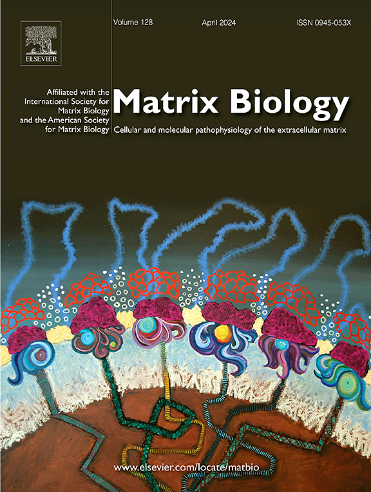ADAMTS4切割软骨寡聚基质蛋白(COMP)产生与骨关节炎和其他形式的退行性关节疾病相关的新表位。
IF 4.8
1区 生物学
Q1 BIOCHEMISTRY & MOLECULAR BIOLOGY
引用次数: 0
摘要
骨关节炎(OA)是一种高发的关节疾病,影响着全球数百万人,其特点是关节软骨退化、软骨下骨重塑和低度炎症,导致疼痛、僵硬和残疾。软骨低聚物基质蛋白(COMP)是软骨的主要结构成分,其降解被认为是 OA 严重程度/进展的标志物。有几种蛋白酶可在体外裂解 COMP,但目前还不清楚在骨关节炎关节中哪种 COMP 酶具有活性。在这里,我们利用纯化的重组蛋白证明,具有血栓软骨基序 4 的崩解酶和金属蛋白酶(ADAMTS4)是最有效的 COMP 酶,其次是 ADAMTS1。利用液相色谱-串联质谱法,我们确定了 ADAMTS4 和 ADAMTS1 活性在 COMP 中产生的几个新的裂解位点。S77-V78 处的裂解破坏了 COMP 的五聚体组织,并产生了一种之前在 OA 患者滑液中发现的新肽。使用抗 QQS77 抗体的免疫印迹证实,ADAMTS4 能有效地裂解这种肽键。通过分析五种 ADAMTS4 变体,我们发现 C 端间隔域是 COMPase 活性所严格必需的,并确定了参与与 COMP 相互作用的特定残基。抑制性抗 ADAMTS4 抗体可显著减少 COMP QQS77 新表位在人类 OA 软骨外植体中的生成,这表明 ADAMTS4 是 OA 中生成 QQS77 新肽的关键蛋白酶。由于 ADAMTS4 的另一个主要底物是软骨中含量最高的蛋白多糖 aggrecan,这些发现突出表明,通过同时裂解 COMP 和 aggrecan,ADAMTS4 可在调节软骨结构完整性方面发挥关键作用。本文章由计算机程序翻译,如有差异,请以英文原文为准。
Cleavage of Cartilage Oligomeric Matrix Protein (COMP) by ADAMTS4 generates a neoepitope associated with osteoarthritis and other forms of degenerative joint disease
Osteoarthritis (OA) is a highly prevalent joint disease, affecting millions of people worldwide and characterized by degradation of articular cartilage, subchondral bone remodeling and low-grade inflammation, leading to pain, stiffness and disability. Cartilage Oligomeric Matrix Protein (COMP) is a major structural component of cartilage and its degradation has been proposed as a marker of OA severity/progression. Several proteases cleave COMP in vitro, however, it is unclear which of these COMPase activities is prevalent in an osteoarthritic joint. Here, using purified recombinant proteins, we show that A Disintegrin And Metalloproteinase with Thrombospondin motifs 4 (ADAMTS4) is the most potent COMPase, followed by ADAMTS1. Using liquid chromatography-tandem mass spectrometry, we identified several novel cleavage sites in COMP resulting from ADAMTS4 and ADAMTS1 activity. Cleavage at S77-V78 disrupted the pentameric organization of COMP and generated a neopeptide previously identified in the synovial fluid of OA patients. Immunoblots with anti-QQS77 antibodies confirmed that ADAMTS4 efficiently cleaved this peptide bond. By analyzing five ADAMTS4 variants, we found that the C-terminal spacer domain is strictly necessary for COMPase activity and identified the specific residues involved in the interaction with COMP. An inhibitory anti-ADAMTS4 antibody significantly decreased generation of the COMP QQS77 neoepitope in human OA cartilage explants, implicating ADAMTS4 as a key protease in generating the QQS77 neopeptides in OA. Since another major ADAMTS4 substrate is aggrecan, the most abundant proteoglycan in cartilage, these findings highlight that, by cleaving both COMP and aggrecan, ADAMTS4 may play a crucial role in modulating the structural integrity of cartilage.
求助全文
通过发布文献求助,成功后即可免费获取论文全文。
去求助
来源期刊

Matrix Biology
生物-生化与分子生物学
CiteScore
11.40
自引率
4.30%
发文量
77
审稿时长
45 days
期刊介绍:
Matrix Biology (established in 1980 as Collagen and Related Research) is a cutting-edge journal that is devoted to publishing the latest results in matrix biology research. We welcome articles that reside at the nexus of understanding the cellular and molecular pathophysiology of the extracellular matrix. Matrix Biology focusses on solving elusive questions, opening new avenues of thought and discovery, and challenging longstanding biological paradigms.
 求助内容:
求助内容: 应助结果提醒方式:
应助结果提醒方式:


